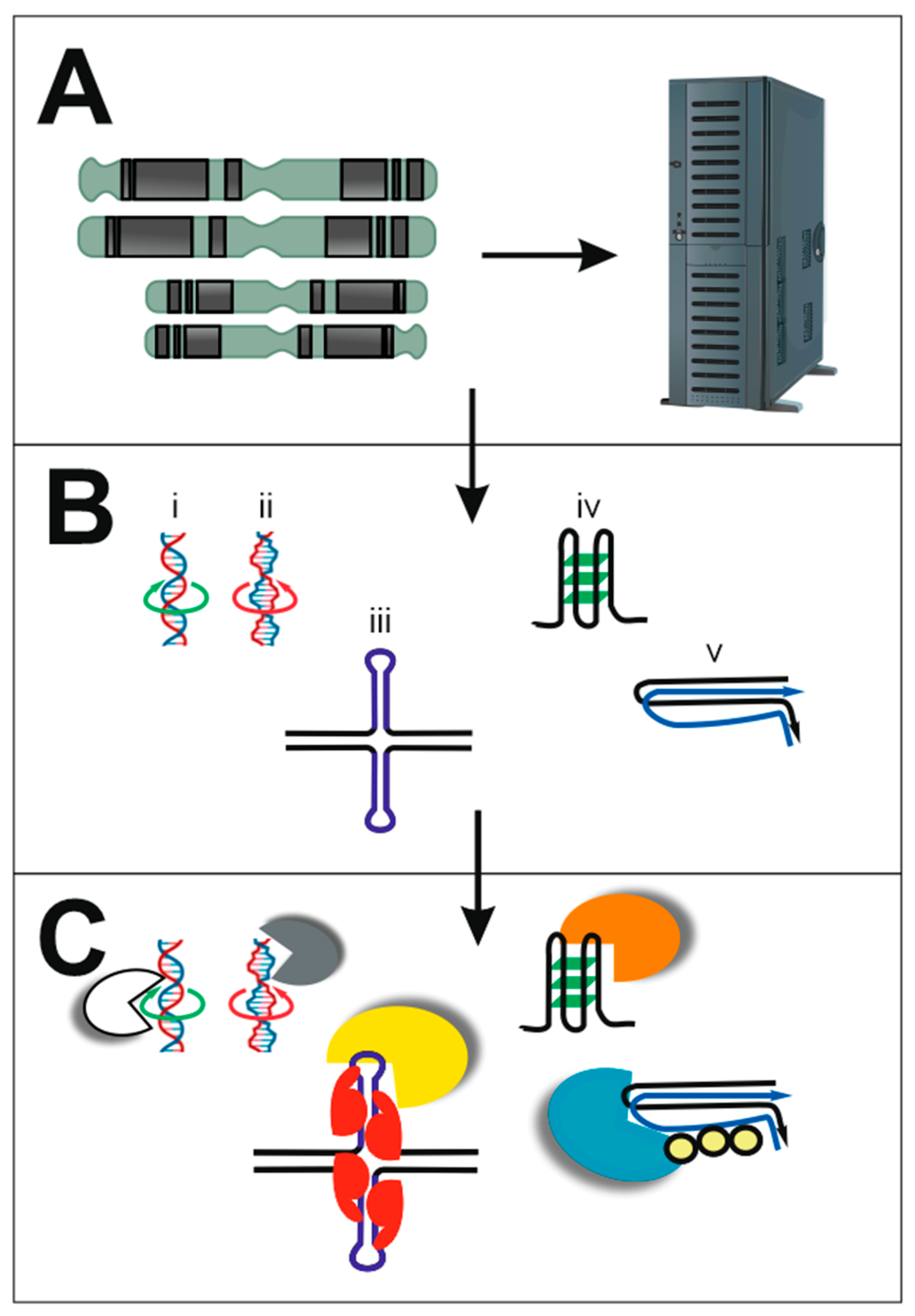Impacts of Molecular Structure on Nucleic Acid–Protein Interactions
Author Contributions
Funding
Institutional Review Board Statement
Informed Consent Statement
Data Availability Statement
Conflicts of Interest
References
- Cozzolino, F.; Iacobucci, I.; Monaco, V.; Monti, M. Protein–DNA/RNA Interactions: An Overview of Investigation Methods in the Omics Era. J. Proteome Res. 2021, 20, 3018–3030. [Google Scholar] [CrossRef] [PubMed]
- Corley, M.; Burns, M.C.; Yeo, G.W. How RNA-Binding Proteins Interact with RNA: Molecules and Mechanisms. Mol. Cell 2020, 78, 9–29. [Google Scholar] [CrossRef] [PubMed]
- Brazda, V.; Fojta, M.; Bowater, R.P. Structures and stability of simple DNA repeats from bacteria. Biochem. J. 2020, 477, 325–339. [Google Scholar] [CrossRef] [PubMed]
- Wang, G.; Vasquez, K.M. Dynamic alternative DNA structures in biology and disease. Nat. Rev. Genet. 2022, 1–24. [Google Scholar] [CrossRef] [PubMed]
- Bansal, A.; Kaushik, S.; Kukreti, S. Non-canonical DNA structures: Diversity and disease association. Front. Genet. 2022, 13, 959258. [Google Scholar] [CrossRef] [PubMed]
- Bartas, M.; Červeň, J.; Guziurová, S.; Slychko, K.; Pečinka, P. Amino Acid Composition in Various Types of Nucleic Acid-Binding Proteins. Int. J. Mol. Sci. 2021, 22, 922. [Google Scholar] [CrossRef] [PubMed]
- Zhuravlev, A.V.; Zakharov, G.A.; Anufrieva, E.V.; Medvedeva, A.V.; Nikitina, E.A.; Savvateeva-Popova, E.V. Chromatin Structure and “DNA Sequence View”: The Role of Satellite DNA in Ectopic Pairing of the Drosophila X Polytene Chromosome. Int. J. Mol. Sci. 2021, 22, 8713. [Google Scholar] [CrossRef] [PubMed]
- Choi, S.; Lee, G.; Kim, J. Cellular Computational Logic Using Toehold Switches. Int. J. Mol. Sci. 2022, 23, 4265. [Google Scholar] [CrossRef] [PubMed]
- Víglaský, V. Hidden Information Revealed Using the Orthogonal System of Nucleic Acids. Int. J. Mol. Sci. 2022, 23, 1804. [Google Scholar] [CrossRef] [PubMed]
- Zhao, X.; Usdin, K. (Dys) function Follows Form: Nucleic Acid Structure, Repeat Expansion, and Disease Pathology in FMR1 Disorders. Int. J. Mol. Sci. 2021, 22, 9167. [Google Scholar] [CrossRef] [PubMed]
- Bartas, M.; Slychko, K.; Brázda, V.; Červeň, J.; Beaudoin, C.A.; Blundell, T.L.; Pečinka, P. Searching for New Z-DNA/Z-RNA Binding Proteins Based on Structural Similarity to Experimentally Validated Zα Domain. Int. J. Mol. Sci. 2022, 23, 768. [Google Scholar] [PubMed]
- Bowater, R.P.; Bohálová, N.; Brázda, V. Interaction of Proteins with Inverted Repeats and Cruciform Structures in Nucleic Acids. Int. J. Mol. Sci. 2022, 23, 6171. [Google Scholar] [CrossRef] [PubMed]
- Bezzi, G.; Piga, E.J.; Binolfi, A.; Armas, P. CNBP Binds and Unfolds In Vitro G-Quadruplexes Formed in the SARS-CoV-2 Positive and Negative Genome Strands. Int. J. Mol. Sci. 2021, 22, 2614. [Google Scholar] [CrossRef] [PubMed]
- Bohálová, N.; Cantara, A.; Bartas, M.; Kaura, P.; Šťastný, J.; Pečinka, P.; Brázda, V. Tracing dsDNA Virus–Host Coevolution through Correlation of Their G-Quadruplex-Forming Sequences. Int. J. Mol. Sci. 2021, 22, 3433. [Google Scholar] [CrossRef] [PubMed]
- Trizna, L.; Janovec, L.; Halaganová, A.; Víglaský, V. Rhodamine 6G-Ligand Influencing G-Quadruplex Stability and Topology. Int. J. Mol. Sci. 2021, 22, 7639. [Google Scholar] [CrossRef] [PubMed]
- Volná, A.; Bartas, M.; Karlický, V.; Nezval, J.; Kundrátová, K.; Pečinka, P.; Červeň, J. G-Quadruplex in Gene Encoding Large Subunit of Plant RNA Polymerase II: A Billion-Year-Old Story. Int. J. Mol. Sci. 2021, 22, 7381. [Google Scholar] [CrossRef] [PubMed]
- Bartas, M.; Brázda, V.; Volná, A.; Červeň, J.; Pečinka, P.; Zawacka-Pankau, J.E. The Changes in the p53 Protein across the Animal Kingdom Point to Its Involvement in Longevity. Int. J. Mol. Sci. 2021, 22, 8512. [Google Scholar] [CrossRef] [PubMed]
- Brázda, V.; Bartas, M.; Bowater, R.P. Evolution of Diverse Strategies for Promoter Regulation. Trends Genet. 2021, 37, 730–744. [Google Scholar] [CrossRef] [PubMed]
- Church, D.M. A next-generation human genome sequence. Science 2022, 376, 34–35. [Google Scholar] [CrossRef] [PubMed]
- Nurk, S.; Koren, S.; Rhie, A.; Rautiainen, M.; Bzikadze, A.V.; Mikheenko, A.; Phillippy, A.M. The complete sequence of a human genome. Science 2022, 376, 44–53. [Google Scholar] [CrossRef] [PubMed]

Disclaimer/Publisher’s Note: The statements, opinions and data contained in all publications are solely those of the individual author(s) and contributor(s) and not of MDPI and/or the editor(s). MDPI and/or the editor(s) disclaim responsibility for any injury to people or property resulting from any ideas, methods, instructions or products referred to in the content. |
© 2022 by the authors. Licensee MDPI, Basel, Switzerland. This article is an open access article distributed under the terms and conditions of the Creative Commons Attribution (CC BY) license (https://creativecommons.org/licenses/by/4.0/).
Share and Cite
Bowater, R.P.; Brázda, V. Impacts of Molecular Structure on Nucleic Acid–Protein Interactions. Int. J. Mol. Sci. 2023, 24, 407. https://doi.org/10.3390/ijms24010407
Bowater RP, Brázda V. Impacts of Molecular Structure on Nucleic Acid–Protein Interactions. International Journal of Molecular Sciences. 2023; 24(1):407. https://doi.org/10.3390/ijms24010407
Chicago/Turabian StyleBowater, Richard P., and Václav Brázda. 2023. "Impacts of Molecular Structure on Nucleic Acid–Protein Interactions" International Journal of Molecular Sciences 24, no. 1: 407. https://doi.org/10.3390/ijms24010407
APA StyleBowater, R. P., & Brázda, V. (2023). Impacts of Molecular Structure on Nucleic Acid–Protein Interactions. International Journal of Molecular Sciences, 24(1), 407. https://doi.org/10.3390/ijms24010407





